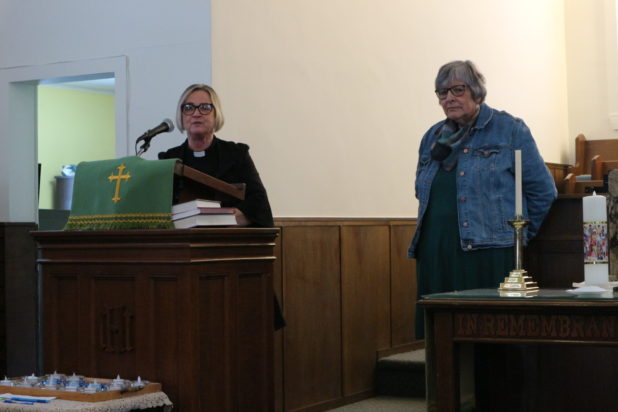Headline News
Call for housing first as sanctuary closes
February 4, 2020

Feb. 4, 2020
By Chris Drost
At a meeting of community representatives on Dec. 10, 2019, the stage was set for creating a warming centre in Bancroft as a short-term strategy for individuals in the area who find themselves homeless this winter. Within the week, Reverend Lynn Watson approached the church elders at St. Paul’s United and almost immediately its doors were opened as a sanctuary for those who needed it.
The generosity did not stop there. In the following weeks volunteers stepped up to act as hosts for the overnight guests, other churches, community organizations and individuals provided everything from food to blankets to personal products and more.
A few short weeks later, on Jan. 20, the church announced that sadly, they were having to close the sanctuary down.
A press conference was announced for the afternoon of Jan. 28 at the church to give the community the information first-hand about why the sanctuary had to be closed. Reverend Lynn Watson opened the meeting by saying, “Through this press conference we hope to dispel rumours and hate towards our neighbours. We also hope that our children and grandchildren do not end up living in a church basement.”
Watson says that through the warming sanctuary experience, and as a person born and raised in the community and a minister in the area for eight years, she has learned a number of things.
“We underestimated the scope of the homelessness issue in the community but did not underestimate the will of the congregation to help,” she said. While the initiative sometimes felt like “chaos,” according to Watson, at the same time “it was an opportunity.”
“We did not underestimate the donations and kindness from many. We live in an amazing part of the province. What we did underestimate is the complexities of issues around homelessness.”
Some individuals have suggested that the homeless are “just addicts.” Watson pointed out that to the contrary, individuals become homeless for a variety of reasons.
“It is much more tangled,” she said. Some may be socially compromised and lack the skills for finding a home, some may have experienced an injury and
others may have addiction issues.” Watson went on to share a personal story of how she was able to help someone close to her to navigate the system. “Not everyone has someone to help them,” she said.
Judy Edgar, who organized many of the logistics around the sanctuary, said, “We hear all the time, ‘these people’ or ‘them’. … I met people I fell in love with. They are brilliant, courageous and proud.” She told the story of individuals using the sanctuary and how “they took it on as their home.” They cleaned it, took out the garbage and shovelled snow.
“One of the good things that came out of the experience is that we now have a list of 100 volunteers,” said Edgar. “What happened to all of us – it changed us. Now I have seen this, I will never be the same.”
“We should be ashamed this is happening in our community,” added Edgar, before thanking all the volunteers who came out to help.
In over our depths
Watson explained, “We realized we got in over our depths.” While those with experience in other communities have indicated that the Bancroft experience happens everywhere, “we lacked the training,” said Watson. She continued by sharing the story of what happened on the day the decision was made to close the sanctuary. First she pointed out clearly that “there is no concrete evidence of drugs or drug use on the premises. That doesn’t mean people may not have used it elsewhere. We did not turn people away.”
To dispel inaccuracies out in the community and on social media, Watson explained that a young man could not be roused. “It was not an overdose of illegal drugs. The individual thought it was something he had taken to make him sleep.” Unfortunately, “no one at the hospital did a blood test to see what he had taken. Shame on them. He was treated as a homeless drug addict – this is not acceptable.” The individual is now in a rehabilitation program and so Watson says “that is a good thing to come out of it.”
“We made a decision to provide a place of warmth and food, but we were not trained,” said Edgar. Training had been scheduled through North Hastings Community Trust prior to the sanctuary closing. “As a church we could really only handle six or seven people because of other things going on at the church.” On the last evening the sanctuary was open they had 15 or 16 individuals staying at the church. In total, 25 different people used the sanctuary over the period it was open.
Awareness results in new Heat Program
One of the other benefits to come out of the experience is that others in the community have become better informed about the homelessness issue. Local realtor Emma Kearns came to NHCT when she found out that many people in the community have no heat. She has gone ahead and donated funds to a get a Heat Program going for those who do not use wood, and may already receive help through NHCT’s Wood Share Program. Watson explained that some people have a place to live, such as an unheated trailer or a tent, but have no heat.
“The sanctuary is just a band aid solution,” said Watson.
In the County of Hastings last homelessness enumeration, it only identified three homeless people in North Hastings. “This is not the reality,” stressed Watson. One unit in Woodview Lane has 10 people in it who cannot find housing elsewhere. “Affordable and safe housing needs to be available for everyone,” she said.
Housing first is a priority
“Housing first,” is the best way of tackling this tangle of needs, according to Watson. “We need to be brave, intentional and creative,” she said. She added that we need to have our professionals trained in working with individuals who have
housing insecurity, doctors, nurses and the police. Watson said that the OPP who came to the sanctuary were kind and showed respect to those using it. “It was a great experience with our local OPP,” she said.
“If our neighbours are suffering, we are all suffering,” Watson said. Nights after being at the sanctuary she felt so grateful for a warm and clean bed. “We need to know that when we go to work it will pay enough for shelter, food, sports for our kids. It is not $14 per hour.”
“Maybe we need to push again for a guaranteed annual income. Poverty is at the centre of it all,” she added.
At the end of the formal presentation, Watson opened it up for questions from the approximately 30 in attendance.
Kearns expressed concern that people going for help are getting shut down by red tape.
Edgar explained that the County of Hastings is not longer giving NHCT the funds for emergencies. People are supposed to be able to access it directly through the county but this is not the case.
Another individual shared the issue of high rents and the difficulties people just getting out of incarceration face when they have no place to go.
Wilma Brethour, one of the volunteers at the sanctuary, said, “Things have got worse, not better. The homelessness we see now is unprecedented. Everyone has a story. Being poor shouldn’t mean you are homeless.”
The issue of rents being increased every time a tenant moves from a unit, was cited as a challenge for people finding affordable housing. “As a community, we need to decide ‘housing first’,” Brethour added.
Another individual made the suggestion to get all the small towns together to have a bigger voice to the upper levels of government.
Deb Jeffrey asked how the County of Hastings could have such poor service for helping individuals to find suitable housing. “They are not responsive and it can take days to get a call back,” she said. “One person was told to get on a bus to Belleville and they would have a space for her in a shelter there. Of course, there is no bus to Belleville from Bancroft.”
Need to lobby provincial government
Mayor Paul Jenkins, who also sits on county council, said, “The real source of lack of funds is from the province as they feed the county with funds for housing. County council recognizes there is not enough money. The focus needs to be on lobbying the province,” according to Jenkins. He thanked everyone who has helped with the sanctuary and said “we can lobby and do our best to push the issue up the ladder.”
While Jenkins indicated that the enumeration of homelessness had already begun through this initiative, it was pointed out that the issue of homelessness is a regional one, not just focused on Bancroft.
Jane Kali of NHCT suggested “all the surrounding mayors and reeves need to make this a priority.”
Joanne Reynolds, who was hired to work on the previous homelessness enumeration by the County of Hastings, said, “I received no training.” “Now in the second phase, a company in Belleville has hired a company from Calgary to do the homelessness enumeration. Are people here going to be willing to share their story with people from out-of-province?”
The time is now
“Where there is a will, there is a way,” said Watson. “The good will has not gone away. We need to get a smaller working group together, one that is diverse, rather than going off in all directions. … I think we have a revolution blossoming.”
As a minister she says she needs to continue to inspire others and to hold the feet of the powers that be to the fire. “We cannot get distracted by how much it is going to cost or who is going to pay for it. These are our people. The time is now,” she said.
While at this point, the church is far from starting the sanctuary up and running again, Watson says it doesn’t mean someone else cannot take it on. A steering committee has already been established for moving forward.
In the interim, a debriefing session for sanctuary volunteers was planned for Jan. 30 and NHCT is planning an upcoming debriefing session for individuals who stayed at the sanctuary.

















